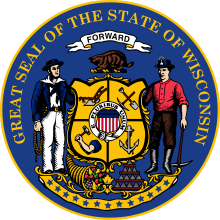Door Peninsula
The Door Peninsula is a peninsula in eastern Wisconsin, separating the southern part of the Green Bay from Lake Michigan. The peninsula includes northern Brown and Kewaunee counties and all of Door County. It is the western portion of the Niagara Escarpment. Well known for its cherry and apple orchards, the Door Peninsula is a popular tourism destination. With the 1881 completion of the Sturgeon Bay Ship Canal, the northern half of the peninsula became an island.[2]
| Designations | |
|---|---|
| Official name | Door Peninsula Coastal Wetlands |
| Criteria | Door County § Wetlands |
| Designated | 10 June 2014 |
| Reference no. | 2218[1] |
Limestone outcroppings of the Niagara Escarpment are visible on both shores of the peninsula, but are larger and more prominent on the Green Bay side as seen at the Bayshore Blufflands. Progressions of dunes have created much of the rest of the shoreline, especially on the east side. Flora along the shore provide clear evidence of plant succession. The middle of the peninsula is mostly flat, cultivated land. Beyond the peninsula's northern tip is a series of islands, the largest of which is Washington Island. The partially submerged ridge extends farther north, becoming the Garden Peninsula in Upper Michigan.[3]
History
Archaeological evidence shows habitation of the peninsula and its islands by several different Native American groups. Two locations on the peninsula claim to be the landing site of French explorer Jean Nicolet in 1634, who was searching for a water route through North America to Asia: Horseshoe Island, which is part of Peninsula State Park, and Red Banks, which is about 7 miles north of what is now Green Bay.[4] Nicolet is remembered in Wisconsin lore for having mistaken the Ho-Chunk Indians for Asians and celebrating, believing he had reached the Far East. Nicolet had heard long before coming that the people living along these shores were called Winnebago ("the people from the stinking water") and, perhaps erroneously, "the People of the Sea". He concluded that this name meant they were from or living near the Pacific Ocean with its aromatic salt air and that they would be a direct link to the people of China, if not from China.[5]
The name of the peninsula and the county comes from the name of a route between Green Bay and Lake Michigan. Humans, whether Native Americans, early explorers, or American ship captains, have been well aware of the dangerous water passage that lies between the Door Peninsula and Washington Island, connecting the bay to the rest of Lake Michigan. This small strait is now littered with shipwrecks. It was named by the Native Americans and translated into French as Porte des Morts: in English, "Death's Door".
Climate
| ||||||||||||||||||||||||||||||||||||||||||||||||||||||||||||||||||||||||||||||||||||||||||||||||||||||||||||||||||||||||||||
See also
- Peshtigo Fire
- Wisconsin Ledge AVA
Notes
- "Door Peninsula Coastal Wetlands". Ramsar Sites Information Service. Retrieved April 25, 2018.
- Seeing The Light - Sturgeon Bay Ship Canal Pierhead Light
- The Niagara Escarpment Archived 2008-05-02 at the Wayback Machine
- "History". Archived from the original on March 1, 2009. Retrieved April 26, 2008.
- "UW - Green Bay - Wisconsin's French Connections Jean Nicolet Statue". Archived from the original on May 12, 2008. Retrieved April 26, 2008.
- "NASA Earth Observations Data Set Index". NASA. Retrieved January 30, 2016.

